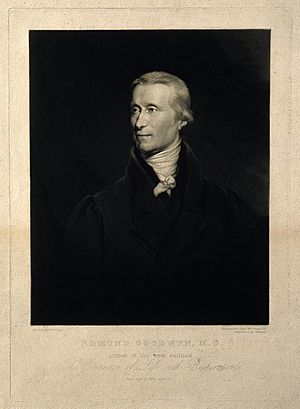Edmund Goodwyn facts for kids
Edmund Goodwyn (1756–1829) was an English doctor. He made several important discoveries. For example, he found out about the diving reflex. He also strongly supported using artificial breathing to help people who couldn't breathe. This was better than other methods used at the time, like heating the body. Goodwyn was also the first to prove that blood keeps flowing through the lungs even when you breathe out.
Contents
Life of Edmund Goodwyn
Edmund Goodwyn was born in Framlingham, United Kingdom, in 1756. His family had lived there since the 1600s. He started his medical training by working for six years with a surgeon named John Page. This was in the nearby town of Woodbridge.
Goodwyn's Education and Friends
From 1779 to 1786, Goodwyn studied medicine at the University of Edinburgh. He learned from famous doctors like William Cullen, Joseph Black, and Alexander Monro Secundus.
He became good friends with Thomas Beddoes, another medical student. Beddoes even dedicated a book about breathing to Goodwyn. Goodwyn also dedicated his own book about drowning to his friend Johannes Theodorus Van der Kemp. Sadly, Van der Kemp later saw his wife and daughter drown. Goodwyn also dedicated the English version of his medical paper to his old teacher, John Page.
Goodwyn's Medical Practice
It seems Goodwyn practiced medicine in London. A famous French writer, Francois-Rene de Chateaubriand, visited him for a lung problem. Chateaubriand wrote that Goodwyn was "famous for his experiments on drowning people." Goodwyn gave him advice for free. Chateaubriand also thought that Goodwyn was the inspiration for a character called Dr. Goodenough in a book by William Makepeace Thackeray.
Goodwyn's Later Life
Edmund Goodwyn died in Framlingham in 1829. He is buried in the Framlingham church. An inscription there says he was very smart and talented. It also says he was known for being kind and religious. His picture is kept at the National Portrait Gallery in London.
Goodwyn's Important Medical Work
Between the mid-1700s and early 1900s, many doctors worried about telling if someone was truly dead. This was partly because of a book by Jacques-Bénigne Winslow. It claimed people could be in a "suspended animation" state, like being in a deep coma. The book suggested that these people shouldn't be buried until their bodies showed clear signs of decay. Goodwyn's medical paper strongly disagreed with these ideas.
Experiments on Drowning
Goodwyn did experiments to find out what really happens when someone drowns. He studied animals like cats, dogs, rabbits, toads, and lizards. He looked at their blood color inside their lungs. He saw that when animals couldn't breathe, their blood didn't turn bright red (oxygenated). This happened even if only a little water got into their lungs.
Goodwyn was the first to realize that water didn't directly hurt the lungs. Instead, it stopped air from getting in. This is what caused drowning. In some experiments, he even blew air into the lungs of toads and lizards that had drowned. Their blood turned red again, and their hearts started beating!
Because of these findings, Goodwyn said it was wrong to use terms like "suspended animation." He believed these terms made people think they could bring someone back to life from a "lifeless mass." He argued they were actually just treating a medical problem. Even with Goodwyn's warning, the idea of "suspended animation" lasted for a long time.
Artificial Ventilation and Blood Flow
Goodwyn's experiments showed that using artificial breathing was much better than other old methods. These methods included using heat, electricity, or even tobacco smoke. He compared these methods and proved that artificial breathing worked best. He wrote that other remedies only worked indirectly. Artificial breathing, however, worked directly.
Goodwyn also proved wrong the idea that blood flow in the lungs stopped when you breathed out. He showed that the amount of air you breathe out normally is too small to stop blood flow. He concluded that "blood circulates through the pulmonary vessels in all the degrees of natural respiration." A famous French doctor, Xavier Bichat, even recognized Goodwyn's work in his own book.
Awards and Recognition
Goodwyn's important work earned him a gold medal in 1788 from the Royal Humane Society of London. For nearly 150 years, the discovery of the diving reflex was wrongly given to another scientist, Paul Bert. But eventually, Goodwyn was correctly given credit for this discovery.


